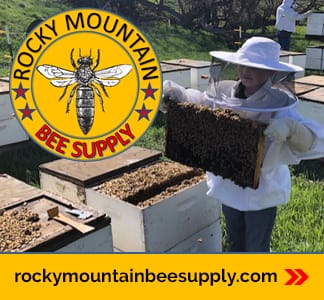HOW TO IDENTIFY A SUSPECTED PESTICIDE BEE KILL AND WHAT TO DO ABOUT IT
By: Pat Donahue
- Identifying a Suspected Pesticide Bee Kill. What the beekeeper will observe:
- A sudden large number of dead bees at the entrance of the hive and in front of the hive (more than 100/day is a normal average amount).
- adult bees in front of the hive that appear disoriented, unable to fly, and/or exhibit signs of paralysis or jerky movements if the pesticide exposure is recent.
- Lack of foragers in front of the hive (not weather related).
- Too few adult bees relative to the size of the brood nest.
- Agitation or aggression in the bees’ behavior.
- Dying adult bees will have a fully extended proboscis (tongue), odd angle of the wings, hind legs outstretched behind them.
- Severe cases: dead bees in the hive, dead brood due to pesticide exposure, starvation, chilled, or overheating due to a lack of adult bees to care for the brood.
- Queen failure within 30 days.
- References for above information. (D.F. Mayer, Ph.D., July 1999); and (Dewey Caron, 2022).
- How to Save your Surviving Colony:
- If possible or practical, move the hive(s) to a safe location. If this is not possible and the exposure was recent, consider closing the hive off for a day or two, (with an entrance cover that allows for adequate ventilation). This reduces the number of additional contaminated bees, drifters and/or robbers from entering the hive. The most serious pesticide kills occur when bees bring back contaminated pollen and store it in the hive. This impacts the foragers, the brood and the other bees in the hive. (Dewey Caron, 2022). Further, a pesticide exposure and resulting bee kill will weaken the hive and make it susceptible to robbers.
- Remove any supers. This will help the surviving colony to stay warm.
- Removing the pollen and honey in the hive is an option and may reduce continued exposure to pesticide contamination.
- Feed the colony with 1:1 sugar syrup until the colony is recovered.
- Feed the colony a pollen substitute until the colony is recovered.
- Add capped brood and nurse bees to the hive to bolster the bee population within the hive.
- Monitor the colony over the next 30 days for signs of queen failure. If noted, replace the queen.
III. Steps to Take When you Suspect a Pesticide Bee Kill:
- Reporting:
- Step One: If you suspect a pesticide poisoning, you should report the incident to the Colorado Department of Agriculture. (CDA). Division of Plant Industry, Pesticide Programs. The contact number to report a suspected pesticide poisoning is (303) 869-9059. The CDA does not provide an online reporting method. Reports are to be done verbally.
- Step Two: Pursuant to the Federal Insecticide, Fungicide, and Rodenticide Act (FIFRA), States are not required to report a bee kill to the EPA. Therefore, your next step should be to report the incident to the Pollinators Stewardship Council. The Council will share the information with the EPA. There is a basic form on the Pollinators Stewardship Council website that you can fill out and submit online. Click here to access the form: https://www.pollinatorstewardship.org/report-a-bee-kill.
- Step Three: The next place to report a suspected bee kill is through the National Pesticide Information Center (NPIC) via the NPIC Ecological Pesticide Incident Reporting portal. Click here to access the form: http://npic.orst.edu/eco/. You can also call the NPIC hotline at 1-800-858-7378.
- Step Four: Finally, you can contact the Environmental Agency (EPA) directly to report a bee kill. This can be done either by sending an email to [email protected]. Alternatively, you can send an email to [email protected].
If you have any difficulty, you can contact the President of your local bee club or the President of the CSBA for assistance and information.
- Investigation:
When a suspected bee kill complaint is filed, the individual who made the report will be contacted by the CDA Pesticide Enforcement Pesticide Section within 24 or 48 hours and sometimes the same day. Reports filed on Friday are followed up on the following Monday. (Matthew Lopez. 2023). The guidelines for the CDA to use when conducting an investigation are set forth in the Federal Insecticide, Fungicide, and Rodenticide Act (FIFRA) Inspection Manual and the Guidance for Inspecting Alleged Cases of Pesticide Related Bee Incidents. (EPA). These Guidelines include the following steps: (1) interviewing the person who reported the incident; (2) pre planning inspection to gather information about location, weather, and any reports of incidents by pesticide registrants; (3) onsite inspection to interview the beekeeper, inspection of the site and collection of samples; (4) identification and inspection of any potential pesticide sources; (5) conducting a pesticide investigation of any potential sources; (6) completion of the inspection(s) and preparation and completion of an inspection report as outlined in the FIFRA Inspection Manual and (7) sending samples to the laboratory for testing. CDA’s investigations are conducted under the guidance of the FIFRA/EPA and as such the CDA may not be able to conduct a stepwise investigation and may need to operate outside of this order based on available information at the time of the investigation. For example, the CDA could be taking/sending samples to the lab well before it identifies a potential source of pesticide use. If the CDA is doing the inspection and sample collection, the samples are sent to the USDA’s Agricultural Marketing Service (AMS) and analyzed for approximately 170 known pesticides. (EPA).
- Sample Collection. Who Does it:
- The process of sampling is different depending on whether the CDA does an inspection after a suspected pesticide poisoning is reported or whether the beekeeper is doing the sampling for his or her own purposes.
- CDA Sample Collection Process: If the CDA is involved, an investigator from the CDA performs the sampling or the sampling is done by the beekeeper under the direct supervision of the Inspector. Doing so preserves the chain of command when handling the samples. (EPA). Samples that are needed include: dead and dying bees from outside the hive entrance. Preferably, bees that are dying or exhibiting abnormal movement and not already dead or decaying. If the kill occurred away from the hive, dead bees, vegetation, soil, or water around the kill area are collected. Samples from inside the hive would include honey and honeycomb; swab samples from the hive exterior may be collected to determine whether drift has occurred; vegetation samples around the area of hive; and/or samples of syrup or other bee food /water provided to the hive(s). Live bees which appear to be acting “normally” may also be sampled. Live bees should be frozen quickly to avoid degradation of the pesticide. (EPA). Most pesticides last up to one week; some longer. Mosquito sprays are very fast to dissipate, but the application is generally done at night when the bees are not out foraging. The CDA responds to a pesticide kill report within 24 to 48 hours. Waiting this period for sample collection does not compromise the pesticide testing process. (Matthew Lopez. 2023).
- Beekeeper Sample Collection Process: If the beekeeper is doing the sampling for his or her own purposes, the CDA refers beekeepers to private laboratories. Under this scenario, the cost of testing is paid by the beekeeper. There may be private labs in Colorado that test for pesticides. However, the CDA generally refers people to the University of Montana Pesticide Testing Laboratory because the CDA is familiar with and has confidence about Montana’s price and turnaround time. (Matthew Lopez, 2023). The beekeeper needs to contact the specific lab that will be doing the testing to find out what samples to collect and the procedure for collecting the samples. Facilities that provide pesticide testing include:
- University of Montana, Pesticide Testing Laboratory. Routine diagnoses at the Schutter Diagnostic Laboratory in Montana are free for Montana residents. There is a fee for out of state submissions ($50). Due to sample volume, out of state submissions will be accepted on a case-by-case basis. It is advised to contact the lab before sending an out of state sample. Information on specific testing and sample collection can be found at: https://www.montana.edu/extension/diagnostics/.
- Bee Informed Partnership (BIP) also provides pesticide testing services. BIP provides a testing kit which includes all materials needed for the collection and directions on how to collect the samples. Step by step instructions on what samples to collect and how to collect them can be found on the BIP website. Follow this link to view the sampling protocol: https://beeinformed.org/wp-content/uploads/2019/11/BIP-ERK.DTK-Protocol.pdf. BIP offers a molecular testing service which tests for a variety of diseases. (BIP). Pesticide testing is an add on to the molecular testing and it increases the cost from $475.00 (molecular testing alone) to $1,255.00 for two (2) pesticide samples. If the beekeeper wants the testing done on an expedited basis, the cost increases to $675.00 and $1,455.00 respectively. Follow this link to order the kit: https://beeinformed.org/services/diagnostic/. BIP does not offer pesticide testing only. The cost for this level of testing does not generally outweigh the benefits of determining whether the bee kill was related to pesticides.
- What the beekeeper can do to assist the CDA with a suspected pesticide bee kill:
- It is important for the beekeeper to know the difference between a forager kill and a spray kill so this information can be accurately reported to the CDA and the CDA can better determine whether an investigation is required. (Matthew Lopez. 2023).
- Forager kills: This occurs when the bees are exposed to pesticides as they are out foraging. The beekeeper will see bees outside the hive exhibiting signs of pesticide poisoning; the bees will be at the hive entrance or on the ground twitching on their backs or dead with their proboscis extended. This may be observed in the hive as well.
- Spray kills: In this scenario the beekeeper will still see bees outside the hive exhibiting signs of pesticide poisoning, but he or she will also see a very sudden and a very large number of dead bees at the entrance of the hive and on the ground in front of the hive in addition to the signs described above in paragraph I. The sudden and large number of dead bees outside the hive is a key finding that helps determine whether the kill is the result of a pesticide spray.
- Inspect your hives frequently so you know what normal behavior is and when it changes allowing quick corrective action by the beekeeper and information to be reported as soon as possible to the CDA.
- Keep detailed hive records. The CDA will ask for your beekeeping records. (Matthew Lopez. 2023). This assists the inspector in determining the source or cause of the kill. If the beekeeper cannot provide accurate and detailed records, the CDA must then do additional investigative work to rule out whether the kill was related to the food or treatments the beekeeper used or applied. (Matthew Lopez. 2023). The beekeeper’s records should include the following information:
- Any pesticides (miticides) you use on your hives. Note the product name and registration number, when you applied the treatment and when it was removed.
- Any spraying you see around the area of your hives and note the date, time and weather conditions at the time of the spray.
- What you feed your bees, when you feed your bees and how much.
- Did you leave sufficient honey in the hives for the bees to over-winter. Record what you left and what is remaining in the Spring. Evaluate whether you left enough for the bees or took too much for yourself.
- Did you feed your bees during times of dearth and in the winter. The CDA gets many suspected pesticide kill reports which turn out to be cases of starvation. It is the biggest issue Matthew Lopez of the CDA sees when investigating suspected pesticide kills. (Matthew Lopez. 2023).
- Take photographs of the bees to document what you are observing at the time you see the suspected pesticide kill.
- The CDA is working hard to protect the bees and other pollinators, but they are limited in what they can do. Any assistance the beekeeper can provide is appreciated and helpful. Bees travel up to 3 to 5 miles to forage. If a hive is in a residential area, finding the source of the pesticide exposure can be like finding a needle in a haystack.
- The CDA is tasked with determining whether a product was used in an unlawful manner. They do their best to investigate and make this determination. Just because your bees were exposed to pesticides does not mean someone applied the product unlawfully. (Matthew Lopez. 2023). In my personal experience with the CDA and specifically Matthew Lopez, in dealing with both a suspected pesticide kill and obtaining information for this article, I found him to be very responsive, informative and helpful. He is also quite knowledgeable about bees and beekeeping.
- The best way to handle a pesticide kill is to be proactive:
- Placement of your hive is important. If you know your neighbor sprays pesticides, place your hive away from the property line.
- Talk to your neighbors and let them know you have bees and to please let you know the day before if they intend to spray so you can take the necessary steps to close your hives the night before. Giving your neighbors a jar of honey is helpful.
- Keep your bees healthy and inspect your hives frequently so you can identify problems quickly.
- Provide your bees with good nutrition before and after the honey flow.
- Leave sufficient honey in the hive for over-wintering. The bees need the honey more than the beekeeper does.
- Provide your bees with ample water sources and cover your water sources before or change them after an anticipated or suspected pesticide spray. (NPIC) and (Matthew Lopez. 2023).
- Sign up for Drift Watch, a program in Colorado that is supported by the Department of Agriculture to help protect honeybees from pesticide spray. This mapping tool is meant to help pesticide applicators, crop producers and beekeepers communicate more effectively to promote awareness and stewardship activities to help prevent and manage drift effects. This site features a map interface that clearly shows applicators the locations of registered sites so they can use the information in their ongoing stewardship activities before they spray. (DriftWatch). There are three separate registration links:
- One for applicators called FieldCheck;
- One for specialty crop producers called DriftWatch; and
- One for beekeepers called BeeCheck.
- Monitor mosquito control schedules in your area and sign up to be included on the no spray list. To view the spray schedules for each county or to request that the spray machine is shut-off while passing your residence, visit the following link: https://www.vdci.net/colorado/.
Pesticide Databases
Bees are in trouble as are many of our pollinators. Please do not use chemical control unless you have exhausted all other alternatives. If you feel you must use an insecticide, please refer to the data bases below for information on honey bee toxicity and use the least harmful product available. Remember to READ THE LABEL! Do not apply any insecticide to a blooming plant. Apply pesticides in the early morning or early evening-with evening being preferable-to ensure the product dries completely before a pollinator may come in contact with it.
CDMS–The easiest place to find MSDS and labels.
PAN Pesticide Database
National Pesticide Information Center
Beyond Pesticides
Pesticide Watch
How to Reduce Bee Poisonings from Pesticides (Manual)
National Pesticide Use Maps (by Pesticide)












